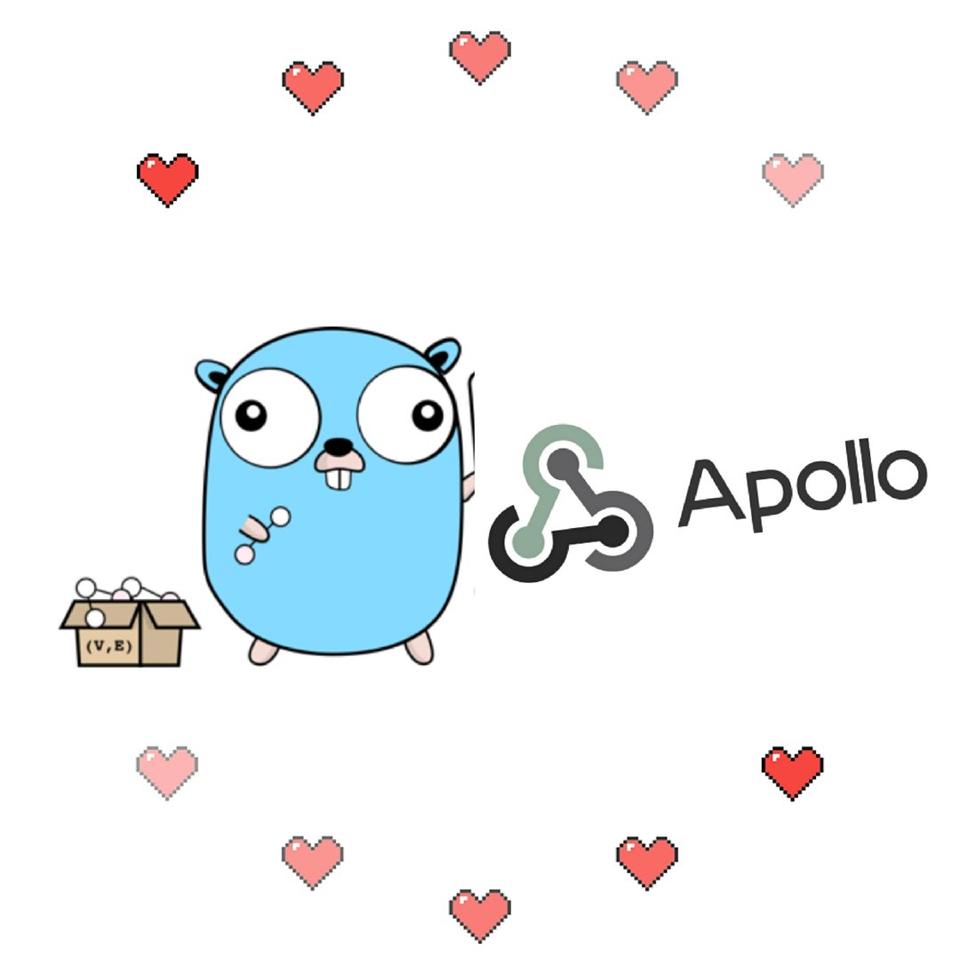java 转 go 遇到 Apollo ?让 agollo 来帮你平滑迁移

Introduction
agollo 是 Apollo 的 Golang 客户端
Apollo(阿波罗)是携程框架部门研发的分布式配置中心,能够集中化管理应用不同环境、不同集群的配置,配置修改后能够实时推送到应用端,并且具备规范的权限、流程治理等特性,适用于微服务配置管理场景。
如果在使用 golang 重构 java 的过程中,使用到了分布式配置中心 Apollo,那么最快的方式就是使用原来的配置,保持最平滑的迁移,这个时候你就需要一个 Apollo 的 golang 客户端,agollo 可以是你的一个选择。
使用指南
1.1.环境要求
- Go 1.11+ (最好使用Go 1.12)
1.2.依赖
1.2.1.使用 go get 方式
go get -u github.com/zouyx/agollo/v3@latest 复制代码
1.2.2.使用 go mod 方式
go.mod
require github.com/zouyx/agollo/v3 latest 复制代码
执行
go mod tidy 复制代码
import
import ( "github.com/zouyx/agollo/v3" ) 复制代码
FAQ
- 为什么要加+incompatible
- go.mod不能下载agollo的解决方法
1.3.必要设置
Apollo 客户端依赖于 AppId,Environment 等环境信息来工作,所以请确保阅读下面的说明并且做正确的配置:
- main : your application
- app.properties (必要) : 连接服务端必要配置
- seelog.xml(非必要)
1.3.1.配置
加载优先级:
- 类配置
- 环境变量指定配置文件
- 默认(app.properties)配置文件
1.3.1.1.类配置
会覆盖 app.properties 中配置,在调用Start方法之前调用
readyConfig:=&AppConfig{ AppId:"test1", Cluster:"dev1", NamespaceName:"application1", Ip:"localhost:8889", } InitCustomConfig(func() (*AppConfig, error) { return readyConfig,nil }) 复制代码 类配置 agollo 的 demo:
package main import ( "fmt" "github.com/zouyx/agollo/v3" "github.com/zouyx/agollo/v3/env/config" ) func InitAgolloConfig() error { readyConfig := &config.AppConfig{ AppID: "test", Cluster: "default", NamespaceName: "application", IP: "localhost:8080", } agollo.InitCustomConfig(func() (*config.AppConfig, error) { return readyConfig, nil }) err := agollo.Start() if err != nil { fmt.Errorf("%v", err) return err } return nil } func main(){ //Init Apollo err := config.InitAgolloConfig() if err != nil { fmt.Errorf("初始化Apollo失败", err) panic(err) } fmt.Println("初始化Apollo配置成功") //Use your apollo key to test value := agollo.GetStringValue("key", "") fmt.Println(value) } 复制代码 1.3.1.2.环境变量指定配置文件
Linux/Mac
export AGOLLO_CONF=/a/conf.properties 复制代码
Windows
set AGOLLO_CONF=c:/a/conf.properties 复制代码
配置文件内容与app.properties内容一样
1.3.1.3.文件配置 - app.properties
1.开发:请确保 app.properties 文件存在于workingdir目录下
2.打包后:请确保 app.properties 文件存在于与打包程序同级目录下,参考1.3.必要配置。
目前只支持json形式,其中字段包括:
-
appId :应用的身份信息,是从服务端获取配置的一个重要信息。
-
cluster :需要连接的集群,默认default
-
namespaceName :命名空间,默认:application(具体定义参考: namespace ), 多namespace使用英文逗号分割 , 非key/value配置(json,properties,yml等),则配置为:namespace.文件类型。如:namespace.json
-
ip :Apollo的CONFIG_SERVICE的ip,非META_SERVICE地址
配置例子如下:
一般配置
{ "appId": "test", "cluster": "dev", "namespaceName": "application", "ip": "localhost:8888" } 复制代码 多namespace配置
{ "appId": "test", "cluster": "dev", "namespaceName": "application, applications1", "ip": "localhost:8888" } 复制代码 非key/value namespace配置
{ "appId": "test", "cluster": "dev", "namespaceName": "application.json,a.yml", "ip": "localhost:8888" } 复制代码 1.4日志组件
参考:
- 自定义日志组件
- 使用seelog日志组件
启动方式
- 异步启动 agollo
场景:启动程序不依赖加载Apollo的配置。
func main() { go agollo.Start() } 复制代码 - 同步启动 agollo(v1.2.0+)
场景:启动程序依赖加载 Apollo 的配置。例:初始化程序基础配置。
func main() { agollo.Start() } 复制代码 - 启动 agollo - 自定义 logger 控件
func main() { agollo.StartWithLogger(loggerInterface) } 复制代码 - 启动 agollo - 自定义 cache 控件 (v1.7.0+)
func main() { agollo.StartWithCache(cacheInterface) } 复制代码 - 启动 agollo - 自定义各种控件 (v1.8.0+)
func main() { agollo.SetLogger(loggerInterface) agollo.SetCache(cacheInterface) agollo.Start() } 复制代码 - 监听变更事件(阻塞)
func main() { event := agollo.ListenChangeEvent() changeEvent := <-event bytes, _ := json.Marshal(changeEvent) fmt.Println("event:", string(bytes)) } 复制代码 基本方法
- String
agollo.GetStringValue(Key,DefaultValue) 复制代码
- Int
agollo.GetIntValue(Key,DefaultValue) 复制代码
- Float
agollo.GetFloatValue(Key,DefaultValue) 复制代码
- Bool
agollo.GetBoolValue(Key,DefaultValue) 复制代码
切换namespace获取配置
- 根据namespace获取配置
config := agollo.GetConfig(namespace) 复制代码
- String
config.GetStringValue(Key,DefaultValue) 复制代码
- Int
config.GetIntValue(Key,DefaultValue) 复制代码
- Float
config.GetFloatValue(Key,DefaultValue) 复制代码
- Bool
config.GetBoolValue(Key,DefaultValue) 复制代码
自定义日志组件
复制以下代码至项目中,并在其中引用日志组件的方法进行打印 log
type DefaultLogger struct { } func (this *DefaultLogger)Debugf(format string, params ...interface{}) { } func (this *DefaultLogger)Infof(format string, params ...interface{}) { } func (this *DefaultLogger)Warnf(format string, params ...interface{}) error { return nil } func (this *DefaultLogger)Errorf(format string, params ...interface{}) error { return nil } func (this *DefaultLogger)Debug(v ...interface{}) { } func (this *DefaultLogger)Info(v ...interface{}){ } func (this *DefaultLogger)Warn(v ...interface{}) error{ return nil } func (this *DefaultLogger)Error(v ...interface{}) error{ return nil } 复制代码 启动
func main() { agollo.SetLogger(&DefaultLogger{}) agollo.Start() } 复制代码 自定义缓存组件
声明自定义缓存组件
//DefaultCache 默认缓存 type DefaultCache struct { defaultCache sync.Map } //Set 获取缓存 func (d *DefaultCache)Set(key string, value []byte, expireSeconds int) (err error) { d.defaultCache.Store(key,value) return nil } //EntryCount 获取实体数量 func (d *DefaultCache)EntryCount() (entryCount int64){ count:=int64(0) d.defaultCache.Range(func(key, value interface{}) bool { count++ return true }) return count } //Get 获取缓存 func (d *DefaultCache)Get(key string) (value []byte, err error){ v, ok := d.defaultCache.Load(key) if !ok{ return nil,errors.New("load default cache fail") } return v.([]byte),nil } //Range 遍历缓存 func (d *DefaultCache)Range(f func(key, value interface{}) bool){ d.defaultCache.Range(f) } //Del 删除缓存 func (d *DefaultCache)Del(key string) (affected bool) { d.defaultCache.Delete(key) return true } //Clear 清除所有缓存 func (d *DefaultCache)Clear() { d.defaultCache=sync.Map{} } //DefaultCacheFactory 构造默认缓存组件工厂类 type DefaultCacheFactory struct { } //Create 创建默认缓存组件 func (d *DefaultCacheFactory) Create()CacheInterface { return &DefaultCache{} } 复制代码 使用自定义缓存
agollo.SetCache(&DefaultCacheFactory{}) agollo.Start() 复制代码 - 项目地址: github.com/zouyx/agoll…
官方资讯*最新技术*独家解读












![[HBLOG]公众号](https://www.liuhaihua.cn/img/qrcode_gzh.jpg)

